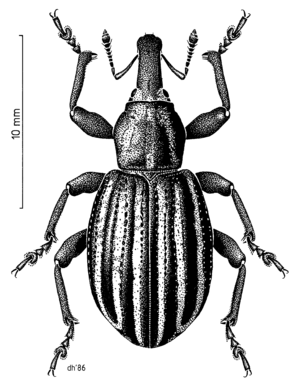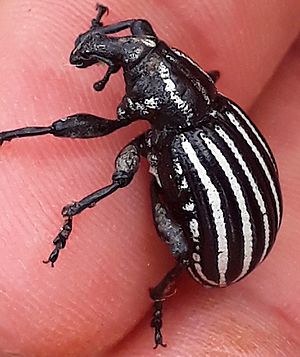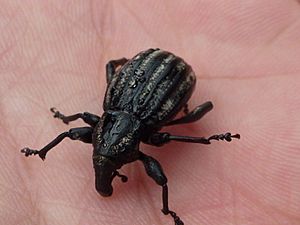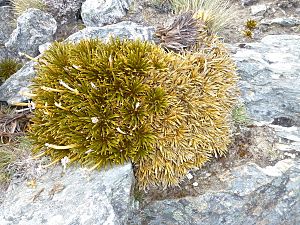Lyperobius hudsoni facts for kids
Quick facts for kids Lyperobius hudsoni |
|
|---|---|
 |
|
| Scientific classification | |
| Genus: |
Lyperobius
|
| Species: |
hudsoni
|
Lyperobius hudsoni is a special kind of weevil that cannot fly. It lives high up in the mountains of Central Otago and Otago Lakes. These areas are found in the South Island of New Zealand.
Contents
Discovering This Weevil
This weevil was first found by George Vernon Hudson in 1894. A scientist named Thomas Broun officially described it in 1914. He named it after George Hudson, who had sent him some specimens. The main example specimen, called a lectotype, is kept at the Natural History Museum, London. George Hudson found it in the Humboldt Range in Central Otago.
What Does It Look Like?
This weevil has a black body. It has special white or yellowish scales on its sides and back. These scales form stripes on its wing covers, called elytra. But these scales can easily rub off. This means the stripes on its wing covers might be missing.
When it was first described, Broun said it was "remarkable." He noted its long body, snout, and antennae grooves. It has a fairly long and thin snout, called a rostrum. This weevil can be from 11.5 to 21.5 millimeters long. That's about the size of a small coin to a large button!
Where It Lives and Its Home
Lyperobius hudsoni lives in the mountain ranges of Central Otago and Otago Lakes. It is found at very high altitudes. These are usually between 1600 and 1900 meters above sea level. You can find this weevil living near its favorite alpine plants. These plants belong to the Apiaceae family.
What This Weevil Eats
The main plants this weevil eats are all from the Apiaceae family. These include several types of speargrass plants. Some examples are Aciphylla dobsonii, A. lecomtei, A. simplex, and A. imbricata. It also eats Anisotome flexuosa.
Adult L. hudsoni weevils eat different parts of speargrass plants. They munch on the leaves, flower stems, and developing seeds. Young weevils, called larvae, usually eat the thick roots of their host plants. However, some L. hudsoni larvae have been found eating the bases of leaves and the plant crowns.
Protecting This Weevil
Lyperobius weevils face several dangers. Their homes are being damaged. Changes in how land is used also cause problems. Another big threat is when introduced animals eat their host speargrass plants.
This weevil is large and cannot fly. This makes it easy for animals like rodents to catch and eat it. Even so, Lyperobius hudsoni is not protected by The 1953 Wildlife Act. This is different from another weevil, Lyperobius huttoni, which is protected.




